Page 257 of 398

{CAUTION:
If you spill fuel and then something ignites it,
you could be badly burned. Fuel can spray out
on you if you open the fuel cap too quickly.
This spray can happen if your tank is nearly
full, and is more likely in hot weather. Open
the fuel cap slowly and wait for any hiss noise
to stop. Then unscrew the cap all the way.
Be careful not to spill fuel. Do not top off or over�ll the
tank and wait a few seconds after you have �nished
pumping before removing the nozzle. Clean fuel
from painted surfaces as soon as possible.
SeeWashing Your Vehicle on page 5-93.
When replacing the fuel cap, turn it clockwise until it
clicks. Make sure the cap is fully installed. The
diagnostic system can determine if the fuel cap has
been left off or improperly installed. This would
allow fuel to evaporate into the atmosphere.
SeeMalfunction Indicator Lamp on page 3-35.
{CAUTION:
If a �re starts while you are refueling, do not
remove the nozzle. Shut off the �ow of fuel by
shutting off the pump or by notifying the
station attendant. Leave the area immediately.
Notice:If you need a new fuel cap, be sure to get
the right type. Your dealer can get one for you.
If you get the wrong type, it may not �t properly.
This may cause your malfunction indicator lamp to
light and may damage your fuel tank and emissions
system. SeeMalfunction Indicator Lamp on
page 3-35.
5-9
Page 261 of 398

A. Windshield Washer Fluid Reservoir. See “Adding
Washer Fluid” underWindshield Washer Fluid
on page 5-44.
B. Battery. SeeBattery on page 5-48.
C. Remote Positive (+) Terminal. SeeJump Starting on
page 5-49.
D. Upper Underhood Fuse Block. See “Underhood
Fuse Block (Upper)” underUnderhood Fuse Block
on page 5-103.
E. Lower Underhood Fuse Block. See “Underhood
Fuse Block (Lower)” underUnderhood Fuse Block
on page 5-103.
F. Engine Coolant Recovery Tank. See “Checking
Coolant” underCooling System on page 5-34.
G. Radiator Pressure Cap. SeeRadiator Pressure Cap
on page 5-31.
H. Power Steering Fluid Reservoir. SeePower Steering
Fluid on page 5-43.I. Engine Coolant Air Bleed Valves (underneath engine
shield). See “How to Add Coolant to the Radiator”
underCooling System on page 5-34.
J. Electric Cooling Fan. SeeCooling System on
page 5-34.
K. Engine Oil Fill Cap. See “When to Add Engine Oil”
underEngine Oil on page 5-18.
L. Engine Oil Dipstick. See “Checking Engine Oil”
underEngine Oil on page 5-18.
M. Automatic Transaxle Fluid Dipstick. See “Checking
the Fluid Level” underAutomatic Transaxle Fluid
on page 5-26.
N. Brake Master Cylinder Reservoir. See “Brake Fluid”
underBrakes on page 5-45.
O. Engine Air Cleaner/Filter. SeeEngine Air
Cleaner/Filter on page 5-25.
5-13
Page 263 of 398

A. Windshield Washer Fluid Reservoir. See “Adding
Washer Fluid” underWindshield Washer Fluid
on page 5-44.
B. Battery. SeeBattery on page 5-48.
C. Remote Positive (+) Terminal. SeeJump Starting on
page 5-49.
D. Upper Underhood Fuse Block. See “Underhood
Fuse Block (Upper)” underUnderhood Fuse Block
on page 5-103.
E. Lower Underhood Fuse Block. See “Underhood
Fuse Block (Lower)” underUnderhood Fuse Block
on page 5-103.
F. Engine Coolant Recovery Tank. See “Checking
Coolant” underCooling System on page 5-34.
G. Radiator Pressure Cap. SeeRadiator Pressure Cap
on page 5-31.
H. Electric Cooling Fan. SeeCooling System on
page 5-34.I. Power Steering Fluid Reservoir (low in engine
compartment). SeePower Steering Fluid on
page 5-43.
J. Engine Oil Dipstick. See “Checking Engine Oil”
underEngine Oil on page 5-18.
K. Engine Oil Fill Cap. See “When to Add Engine Oil”
underEngine Oil on page 5-18.
L. Engine Coolant Air Bleed Valves (underneath engine
shield). See “How to Add Coolant to the Radiator”
underCooling System on page 5-34.
M. Automatic Transaxle Fluid Dipstick. See “Checking
the Fluid Level” underAutomatic Transaxle Fluid
on page 5-26.
N. Brake Master Cylinder Reservoir. See “Brake Fluid”
underBrakes on page 5-45.
O. Engine Air Cleaner/Filter. SeeEngine Air
Cleaner/Filter on page 5-25.
5-15
Page 265 of 398

A. Windshield Washer Fluid Reservoir. See “Adding
Washer Fluid” underWindshield Washer Fluid
on page 5-44.
B. Battery. SeeBattery on page 5-48.
C. Radiator Pressure Cap. SeeRadiator Pressure Cap
on page 5-31.
D. Underhood Fuse Block. SeeUnderhood Fuse Block
on page 5-103.
E. Remote Positive (+) Terminal. SeeBattery on
page 5-48.
F. Engine Coolant Recovery Tank. See “Checking
Coolant” underCooling System on page 5-34.
G. Electric Cooling Fan. SeeCooling System on
page 5-34.H. Power Steering Fluid Reservoir (below generator).
SeePower Steering Fluid on page 5-43.
I. Engine Oil Dipstick. See “Checking Engine Oil”
underEngine Oil on page 5-18.
J. Engine Oil Fill Cap. See “When to Add Engine Oil”
underEngine Oil on page 5-18.
K. Automatic Transaxle Fluid Dipstick. See “Checking
the Fluid Level” underAutomatic Transaxle Fluid
on page 5-26.
L. Brake Fluid Reservoir. See “Brake Fluid” under
Brakes on page 5-45.
M. Engine Air Cleaner/Filter. SeeEngine Air
Cleaner/Filter on page 5-25.
5-17
Page 278 of 398

What to Use
Use a mixture of one-half clean, drinkable water and
one-half DEX-COOL®coolant which will not damage
aluminum parts. If you use this coolant mixture, you do
not need to add anything else.
{CAUTION:
Adding only plain water to your cooling
system can be dangerous. Plain water, or
some other liquid such as alcohol, can boil
before the proper coolant mixture will. Your
vehicle’s coolant warning system is set for the
proper coolant mixture. With plain water or the
wrong mixture, your engine could get too hot
but you would not get the overheat warning.
Your engine could catch �re and you or others
could be burned. Use a 50/50 mixture of clean,
drinkable water and DEX-COOL
®coolant.
Notice:If you use an improper coolant mixture,
your engine could overheat and be badly damaged.
The repair cost would not be covered by your
warranty. Too much water in the mixture can freeze
and crack the engine, radiator, heater core and
other parts.If you have to add coolant more than four times a year,
have your dealer check your cooling system.
Notice:If you use the proper coolant, you do not
have to add extra inhibitors or additives which claim
to improve the system. These can be harmful.
Checking Coolant
The coolant recovery tank
is located between the
power steering �uid
reservoir and the
underhood fuse block, in
the engine compartment,
on the passenger’s
side of the vehicle.
SeeEngine Compartment
Overview on page 5-12
for more information
on location.
The vehicle must be on a level surface. When your
engine is cold, the coolant level should be at the
COLD mark or a little higher. When your engine is
warm, the level should be up to the HOT mark or
a little higher.
5-30
Page 286 of 398

If the overheat warning continues, there is one more
thing you can try. You can add the proper coolant
mixture directly to the radiator, but be sure the cooling
system is cool before you do it.
{CAUTION:
Steam and scalding liquids from a hot cooling
system can blow out and burn you badly.
They are under pressure, and if you turn the
radiator pressure cap — even a little — they
can come out at high speed. Never turn the
cap when the cooling system, including the
radiator pressure cap, is hot. Wait for the
cooling system and radiator pressure cap to
cool if you ever have to turn the pressure cap.
How to Add Coolant to the Radiator
Notice:Your engine has a speci�c radiator �ll
procedure. Failure to follow this procedure could
cause your engine to overheat and be severely
damaged.
1. You can remove the radiator pressure cap when
the cooling system, including the radiator pressure
cap and upper radiator hose, is no longer hot.
Turn the pressure cap slowly counterclockwise until
it �rst stops. Do not press down while turning the
pressure cap.
If you hear a hiss, wait for that to stop. A hiss
means there is still some pressure left.
5-38
Page 287 of 398
2. Then keep turning the pressure cap, but now push
down as you turn it. Remove the pressure cap.
{CAUTION:
You can be burned if you spill coolant on hot
engine parts. Coolant contains ethylene glycol
and it will burn if the engine parts are hot
enough. Do not spill coolant on a hot engine.
3. If you have the 3800 V6 engine, remove the
3800 Series II V6 engine cover shield to access
the bleed valve.
3.1. Clean the area around the engine oil �ll tube
and cap before removing. Twist the oil �ll
tube, with cap attached, counterclockwise
and remove it.
3.2. Lift the engine cover shield at the front, slide
the catch tab out of the engine bracket and
remove the cover shield.
3.3. Put the oil �ll tube, with cap attached, in the
valve cover oil �ll hole until you are ready to
replace the cover shield.
5-39
Page 289 of 398
5. Fill the radiator with the proper DEX-COOL®
coolant mixture, up to the base of the �ller
neck. SeeEngine Coolant on page 5-29for more
information about the proper coolant mixture.
If you see a stream of coolant coming from an
air bleed valve, close the valve. Otherwise,
close the valves after the radiator is �lled.
6. Rinse or wipe any spilled coolant from the engine
and the compartment.7. If you have the 3800 V6 engine, replace the
3800 Series II V6 engine cover shield.
7.1. Remove the oil �ll tube, with cap attached,
from the valve cover.
7.2. Insert the catch tab on the cover shield
under the bracket on the engine.
7.3. Place the hole in the cover shield over the
hole in the valve cover. Install oil �ll tube and
cap by twisting clockwise.
8.
Then �ll the coolant recovery tank to the COLD mark.
9. Put the cap back on the coolant recovery tank,
but leave the radiator pressure cap off.
5-41